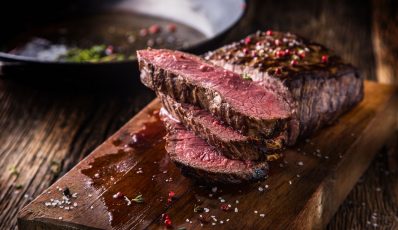High-quality professional kitchen knives are usually expensive, but they are also vital in any well-equipped kitchen. Saving on such basic essentials, and working with poor quality or blunt kitchen knives, can take away all the fun of cooking. There are three basic types of knives you should consider above all. Read on to find out which knives are the most recommended and how to look after them.

High-quality professional kitchen knives are usually expensive, but they are also vital in any well-equipped kitchen. Saving on such basic essentials, and working with poor quality or blunt kitchen knives, can take away all the fun of cooking. There are three basic types of knives you should consider above all. Read on to find out which knives are the most recommended and how to look after them.
The basic kitchen knife
The most important tool in any kitchen is what’s commonly called the chef’s knife. The best chef knives can be used in many different ways. They are also perfect for meat, as well as fish and vegetables. The long and straight blade lets you cut large and tricky ingredients in just a few strokes. The thinner part of the knife is good for simple tasks like slicing onions. This type of knife can be quickly and safely guided along bones when cutting meat. Kitchen knife blades are usually 20 cm long, although there are also smaller versions, which are often used by women, as they are easier to hold. Longer knives are a common sight in professional kitchens, where large amounts of food are cut.
Peeling knives
If you want to precisely peel fruit and vegetables, then you cannot go without a peeling knife. This very useful type of knife is available in many different sizes. Its beak-shaped curved blade makes peeling apples or potatoes much easier. Peeling knives with straight blades, on the other hand, are more universal. They can be used for both peeling and cutting. So peeling knives, with blades between 10 and 15 cm long, should be on every cook’s must-have list, between chef’s knives and all-purpose knives. They can be used for peeling, as well as cutting meat or fish. These knives are practical and easy to use, although there are more important aspects in the kitchen.
Bread knives with sharp edges
A standard bread knife is the third type of knife that is a must in every kitchen. Thanks to its serrated blade, which resembles a saw blade, this knife is suitable for more than just cutting crispy bread crust. It is also great for cutting pastries and hard fruits, such as watermelons. The bread knife’s unique blade stays sharp much longer than traditional blades, and blades at least 21 cm long will let you slice large loaves of bread in one go.
Kitchen knives for ambitious chefs
The basic kitchen knife set that should be used by all professional chefs, i.e. a chef’s knife, peeling knife and bread knife, will suffice for all types of catering events, and you will feel comfortable preparing even the most challenging dishes. Instead of buying cheaper but low-quality knives, it is worth investing a bit more in a good quality knife set with these three types of blades. Depending on the type of dishes you prefer, you can also use other types of knives with additional functions. However, this makes sense if you use them relatively often or if you cut large quantities of food.
- A tomato knife is a small serrated knife that easily cuts through hard tomato skins.
- A soft cheese knife has holes in the blade that prevent cheese from sticking to the blade. A cheddar knife has a wide blade and cleaver shape, which allows you to use force and balance to push downward and cut slices. The wide spine of the blade prevents the knife from bending during cutting. Then there are Granton knives for cutting Gouda-type ripened cheeses, which have a row of small dimples just above the blade. They minimize the contact area between the blade and the cheese and prevent cheese from sticking to the knife.
- A ham knife is a flat, narrow knife that glides smoothly over meat. A boning knife is used for removing the bones from poultry, meat and fish. Its narrow blade is easy to manoeuvre, and an optional flexible blade lets you easily access the most difficult to reach parts of the meat. A salmon knife looks like a ham knife, because of its thin and flexible blade, that allows cutting very small slices. As with the bread knife, the blade of the salmon knife is very long, letting you cut delicate fillets in one go, making it easy and fun.
- Chinese and Japanese chef knives are becoming more and more popular. The most well-known one is the Japanese Santoku knife, approx. 18 cm long, with a slim blade spine. It is perfect for slicing bulky ingredients that can later be easily placed in pans, pots or bowls. A universal Japanese equivalent of the above-mentioned knife is the so-called Petty knife. It is good for peeling and cutting fruit, but also filleting. The Chinese chef’s knife looks like a cleaver chopper, but it works best cutting vegetables. The chopped food remaining on the edge of the knife falls straight into the pot.

Choosing the right kitchen knives
Good kitchen knives guarantee a comfortable grip and solid blades. The trial and error method is the only way to test if the grip fits well in your hand. An ergonomic chef’s knife, held between your thumb and forefinger, with the handle firmly lying on your wrist, should keep still while cutting. However, in the long-term, it is the quality and finishing of the blade that help keep the knife sharp. Is the blade stainless, flexible or very hard? Was it forged or punched? Was it machine or hand sharpened? Depending on what you use it for, a flexible steel blade may be a better option than a hard and stiff blade. If you don’t have time to consider each knife in such detail, then at least try to remember one thing – the best kitchen knife sets will usually put you back more than £50 per knife. It is also worth bearing in mind that you need to properly look after your knives if you want them to stay in good condition. Never wash professional kitchen knives in a dishwasher. Always wash them by hand, as the corrosive detergents used in dishwashers will make even the best professional cooking knives more prone to rusting. Acidic or salty residues should be rinsed off immediately, as they can damage and blunt the blade. Do not use cutting boards made of marble, glass, or other hard materials, as they are too hard and can also end up blunting the blade.








Share